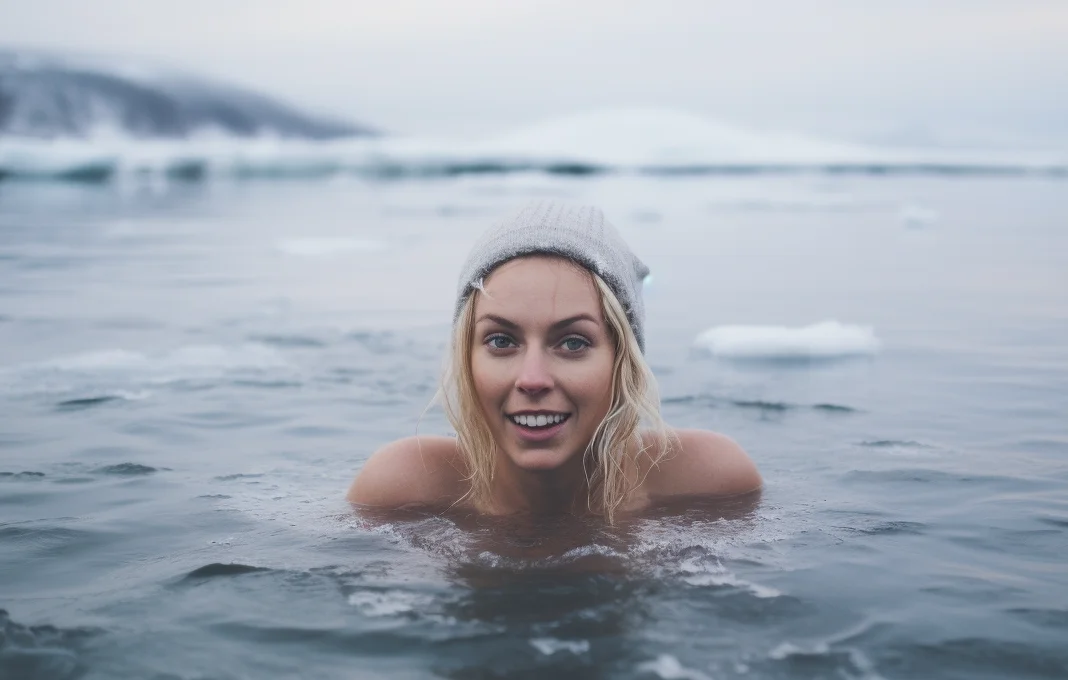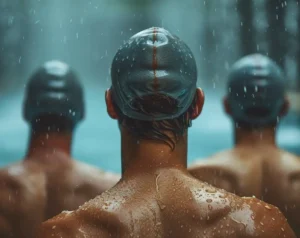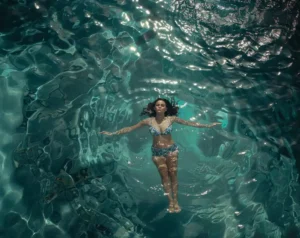If you are looking for a new and exciting way to challenge yourself, ice swimming may be the perfect activity for you. I love ice swimming for many years, not only for its physical and mental benefits but also for the challenge and joy. With this blog post I want to show you why I’m doing this regularly and what you can do to participate on this great swimming experience within freezing water. In this guide, we will provide you with everything you need to know to get started with ice swimming.
Definition of Ice Swimming

Ice swimming, also known as winter swimming, is the practice of swimming in water below 41°F (5°C). It is a growing sport that requires strength, endurance, and mental toughness. This type of swimming is different from regular swimming because it requires a different set of skills and techniques. Ice swimmers need to be able to handle the extreme cold temperatures, which can cause hypothermia and other health risks.
Fascination of Ice Swimming
Ice swimming is a fascinating sport that has attracted many athletes around the world. The sport challenges swimmers to push their limits and overcome their fears. The thrill of swimming in freezing water is something that cannot be described in words. Ice swimming is not only a physical challenge but also a mental one. It requires swimmers to stay focused, calm, and determined in the face of extreme conditions.
Target Audience for This Guide
This guide is designed for beginners who are interested in learning about ice swimming. Whether you are a seasoned swimmer or new to the sport, this guide will provide you with the information you need to get started. We will cover everything from the basics of ice swimming to the body and mind techniques and gear you need to succeed. If you are looking for a new and exciting challenge, ice swimming may be just what you need.
Basics of Ice Swimming
Before taking the plunge into the world of ice swimming, it’s essential to understand the science behind it. Cold exposure is not just about enduring discomfort; it’s a practice that can have profound effects on your body and mind. Here are some basics of ice swimming that every beginner should know.
The Body’s Response to Cold
When you expose your body to cold temperatures, it triggers a series of physiological responses. The blood vessels in your skin constrict to conserve heat, while deeper blood vessels dilate to maintain core body temperature. This process, known as vasoconstriction and vasodilation, improves circulation, which can have a positive impact on various aspects of your health.
Health Benefits
Ice swimming offers a myriad of health advantages. It can bolster your immune system, enhance circulation, and elevate your metabolism. Additionally, cold water swimming can diminish inflammation, alleviate stress, and uplift your mood. Nevertheless, it’s crucial to consult with your doctor before embarking on ice swimming, especially if you have any pre-existing medical conditions.
Top 11 Benefits Of Cold Exposure To Your Body
Engaging in ice bathing yields a variety of benefits, such as:
- Improved Circulation: The alternating constriction and dilation of blood vessels promote cardiovascular health by enhancing blood flow.
- Faster Recovery: Athletes utilize ice baths to mitigate muscle soreness and inflammation following intense workouts.
- Mental Resilience: Cold exposure contributes to enhanced mental clarity, focus, and resilience in the face of discomfort.
- Stress Reduction: The release of endorphins during cold exposure alleviates stress and boosts mood.
- Immune System Support: Cold exposure may stimulate white blood cell production, fortifying the immune system’s response to infections.
- Enhanced Skin Health: Cold exposure improves skin tone, reduces pore appearance, and may benefit conditions like eczema and psoriasis.
- Increased Metabolism: The body burns more calories to generate heat during cold exposure, potentially aiding weight management and promoting fat loss.
- Hormone Regulation: Cold exposure helps balance hormones, including reducing cortisol levels and increasing serotonin and dopamine.
- Mental Clarity and Focus: Enthusiasts often report improved mental clarity, focus, and heightened alertness after cold exposure.
- Positive Mood: Endorphin release during and after ice bathing contributes to an improved mood, reduced depression symptoms, and increased overall well-being.
- Improved Sleep: Some find that ice bathing promotes relaxation, reduces anxiety, and contributes to better sleep.
These diverse benefits underscore the comprehensive advantages of integrating ice bathing into your wellness routine. As you delve further into the guide, you’ll discover how to harness these benefits and safely incorporate ice bathing into your life.
Equipment and Clothing
When it comes to ice swimming, safety should be your top priority. You will need to invest in proper equipment and clothing to protect yourself from the cold water. Here are some essential items you should consider:
- Winter hat (recommended): A thick hat will keep your head warm and reduce heat loss.
- Neoprene gloves and shoes or socks (recommended): Neoprene gloves and socks or shoes will keep your hands and feet warm and protect them from the cold water.
- Thermometer (optional): Just to double-check and feel the icy chill of the water for ourselves!
If you want to go the way of sport ice swimming you will better consider this items
- Swim cap and goggles (recommended): A swim cap will keep your head warm and reduce heat loss. Goggles will protect your eyes from the cold water.
- Neoprene gloves and socks (optional): While neoprene gloves and socks are great for keeping your hands and feet warm, they might not be the most comfortable for swimming.
- Wetsuit (optional): A wetsuit offers insulation, ensuring you stay warm in chilly waters and allowing for extended swimming sessions. Make sure to choose a suit that fits well and is designed for cold water swimming.
- Tow float (optional): A tow float is a safety device that will help you stay visible and afloat in the water. It will also provide a place to store your belongings.
In addition to these items, it is important to have a safety plan in place before you start ice swimming. Make sure to swim with a buddy, stay close to the shore, and never swim alone.
Ice swimming can be a challenging and rewarding experience. By following these basics of ice swimming, you can stay safe and enjoy the health benefits of this extreme sport.
Preparation for Ice Swimming
Before diving into the icy waters, it is crucial to prepare yourself both physically and mentally. Here are some of the things you should consider before taking the plunge.
Medical Examination and Consultation with a Doctor
Before attempting ice swimming, it is essential to get a medical check-up and consult with a doctor. Ice swimming can put a lot of stress on your body, and it is important to ensure that you are physically fit to handle the challenge. Your doctor can advise you on any precautions you need to take and recommend exercises to improve your cardiovascular fitness.
Acclimatization to Cold Water
Acclimatization to cold water is crucial before attempting ice swimming. Start by gradually exposing yourself to colder water temperatures, and slowly increase the duration of your cold water exposure. This will help your body adapt to the cold and reduce the risk of hypothermia.
Pro Tip: Get Warm With Cold Showers
Ever since I started swimming in my childhood, cold showers have been a steadfast part of my routine. It wasn’t just my mother’s gentle reminder to rinse with cold water after every bath or shower; it was also the unwavering pre-training ritual of a brisk cold shower. These practices, ingrained in me from a young age, have laid the foundation for what was to come – my foray into the exhilarating world of ice swimming.
Start to shower cold after each warm bath or shower. Begin with a temperature which is a little bit cold to your opinion and then decrease the cold shower temperature day by day. Watch your breathing while the cold showers and breath calm and steady.
Body Techniques and Exercises
Proper body techniques and exercises can help you become a better ice swimmer. Focus on improving your breathing technique, as this will help you stay calm and relaxed in the cold water. You should also work on your endurance and strength, as ice swimming can be physically demanding.
Here are some exercises that can help you prepare for ice swimming:
- Cold water showers or baths to acclimatize your body to the cold
- Breath-holding exercises to improve your lung capacity and control
- Cardiovascular exercises such as running, cycling, and swimming to improve your endurance
- Strength training exercises such as squats and lunges to build up your leg muscles
Remember to always listen to your body and take things slowly. With the right preparation and training, you can enjoy the thrill of ice swimming safely and confidently.
Safety in Ice Swimming

Ice swimming can be a thrilling and rewarding experience, but it can also be dangerous if proper safety measures are not taken. As a beginner, it is important to be aware of the risks and how to address them to ensure a safe and enjoyable ice swimming experience.
First Aid Measures
In the event of an emergency, it is important to have basic first aid knowledge and supplies on hand. Some recommended first aid measures to have in your ice swimming kit include:
- A first aid kit with essentials such as bandages, antiseptic, and pain relievers
- A warm blanket or towel to wrap yourself in after swimming
- A thermos of warm liquid to help raise your body temperature
- A cell phone to call for help if needed
Risks and How to Address Them
Ice swimming presents several risks that should be taken seriously. Some of the most common risks and how to address them include:
- Hypothermia: The most significant risk of ice swimming is hypothermia, which occurs when your body temperature drops too low. To prevent hypothermia, it is important to limit your time in the water, wear appropriate gear, and warm up immediately after swimming.
- Cold shock response: When you first enter cold water, your body may experience a cold shock response, which can cause you to gasp for air and increase your heart rate. To prevent this response, it is important to gradually acclimate your body to the cold water by entering slowly and focusing on your breathing.
- Drowning: Ice swimming in open water can be dangerous due to the risk of drowning. To reduce this risk, always swim with a partner, wear a safety buoy, and follow all safety guidelines.
Important Behavioral Guidelines
In addition to taking physical safety measures, it is important to follow behavioral guidelines to ensure a safe and respectful ice swimming experience. Some important guidelines to follow include:
- Check the weather forecast and avoid swimming in extreme cold or windy conditions.
- Never swim alone, always swim with a partner or in a group.
- Wear appropriate gear, such as a wetsuit, swim cap, and goggles.
- Start with short swims and gradually build up to longer distances.
- Listen to your body and exit the water if you start to feel hypothermic or fatigued.
- Respect the environment and wildlife by not disturbing natural habitats or leaving trash behind
- Follow all local laws and regulations regarding ice swimming
- Listen to your body and stop swimming if you feel uncomfortable or experience any pain or discomfort.
By following these safety measures and guidelines, you can enjoy the thrill of ice swimming while minimizing the risks and ensuring a safe and enjoyable experience.
Best Places for Ice Swimming

If you’re looking to try ice swimming, there are many locations around the world where you can take the plunge. Here are some options to consider:
Lakes and Rivers
Many lakes and rivers freeze over in the winter, providing a natural spot for ice swimming. However, it’s important to ensure that the ice is thick enough to support your weight and that the water is safe to swim in. Here are some tips for choosing a safe water body:
- Look for signs that the ice is solid, such as a uniform color and texture.
- Check the thickness of the ice with an ice auger or by drilling a hole.
- Avoid swimming near areas with moving water, such as rivers or streams.
- Choose a location that is monitored by authorities or has a history of safe ice swimming.
Some popular lakes and rivers for ice swimming include:
- Lake Simcoe, Ontario, Canada
- Lake Superior, Michigan, USA
- River Thames, London, UK
- Lake Bled, Slovenia
Organized Ice Swimming Events
If you’re looking for a more structured experience, consider participating in an organized ice swimming event. These events often have safety measures in place and can provide a supportive environment for beginners. Some options include:
- International Ice Swimming Association (IISA) events, held around the world
- Winter Swimming Championships, held in Finland
- Ice Swimming Arctic Cup, held in Norway
- Europe’s biggest ice swimming event, Neuburg a. d. Donau, Germany
Mental Preparation and Challenges
Preparing for ice swimming is not just about physical training. Mental preparation is equally important. Ice swimming can be a challenging and intimidating experience, but with the right mindset and techniques, you can overcome these challenges.
Dealing with Cold Stress
One of the biggest challenges of ice swimming is dealing with the cold stress. Cold stress can cause physical and mental discomfort, and it can be difficult to manage. However, there are several ways to cope with cold stress:
- Breathing techniques: Deep breathing exercises can help you relax and manage stress. Focus on breathing in slowly through your nose and exhaling through your mouth. This can help regulate your heart rate and calm your mind.
- Visualization: Visualize yourself swimming in the cold water and imagine feeling comfortable and relaxed. This can help you feel more confident and prepared for the experience.
- Physical preparation: Prepare your body for the cold by gradually exposing yourself to cooler temperatures. Take cold showers or go for a dip in a cold lake or pool to help your body adapt to the cold.
Meditation and Breathing Techniques
Meditation and breathing techniques can help you stay calm and focused during ice swimming. Here are some techniques to try:
- Meditation: Find a quiet place to sit and focus on your breath. Try to clear your mind and focus on the present moment. This can help you feel more centered and focused.
- Box breathing: Inhale for four seconds, hold for four seconds, exhale for four seconds, and hold for four seconds. Repeat this cycle several times to help regulate your breathing and calm your mind.
- Progressive muscle relaxation: Tense and relax each muscle group in your body, starting from your toes and working your way up to your head. This can help release tension and promote relaxation.
Finding Your Comfort Zone
As you explore the various ice swimming techniques, remember that finding your comfort zone is paramount. Some individuals prefer short, invigorating cold dips, while others may embrace longer, meditative sessions. The key is to discover what works best for you and aligns with your goals and preferences.
Community and Social Support
Joining a community of ice swimmers can provide social support and encouragement. You can share your experiences, learn from others, and build relationships with like-minded individuals. This can help you stay motivated and committed to your ice swimming goals.
In summary, mental preparation is key to succeeding in ice swimming. By using techniques such as breathing exercises, visualization, and meditation, you can manage cold stress and stay focused during the swim. Joining a community of ice swimmers can also provide social support and encouragement.
Advanced Techniques and Challenges
If you are an experienced ice swimmer and want to take your skills to the next level, there are several advanced techniques and challenges that you can try. Here are some of them:
Long-Distance Ice Swimming
If you have already mastered the basics of ice swimming, you can challenge yourself by attempting a long-distance swim in icy waters. A popular long-distance ice swimming challenge is the Ice Mile, which involves swimming one mile (1.6 kilometers) in water that is below 5°C (41°F). To prepare for this challenge, you should gradually increase your training distance and duration, and practice swimming in colder water temperatures.
Ice Baths and Cold Exposure Training
Ice baths and cold exposure training can help you build resilience to cold water and improve your overall health and well-being. The Wim Hof Method is a popular cold exposure training program that involves breathing exercises, cold showers, and ice baths. By exposing your body to cold temperatures, you can stimulate your immune system, reduce inflammation, and increase your energy levels.
The Wim Hof Method
Developed by “The Iceman” Wim Hof, this method combines specific breathing patterns, gradual cold exposure, and meditation. It has gained popularity for its holistic approach to cold exposure and its potential benefits for physical and mental well-being. Many ice bathers find this method to be an effective way to manage the intense cold.
Competitions and Events
If you want to test your ice swimming skills against other swimmers, you can participate in ice swimming competitions and events. The International Ice Swimming Association (IISA) organizes several events around the world, including the Ice Swimming World Championships and the Ice Kilometer. These events attract top ice swimmers from around the world and provide an opportunity to challenge yourself and meet other ice swimming enthusiasts.
Resources and Further Information
If you’re interested in even more ice swimming information, you will find plenty of resources available. Below are some of the most helpful resources for beginners.
Literature and Books
There are several books available that provide information on ice swimming. Some of the most popular books are:
- “Icy Water: The Adventures of an Arctic Adventurer” by Laura E. Young
- “The Ice Swimmer” by Kjell Ola Dahl
- “Swimming in the Sink: An Episode of the Heart” by Lynne Cox.
Online Communities and Forums
Online communities and forums are great places to connect with other ice swimmers and get advice and tips. One of the most active online communities is the International Ice Swimming Association Facebook page. The page has over 15,000 members and is a great place to ask questions and connect with other swimmers.
Training and Courses
If you’re interested in getting more serious about ice swimming, there are several training and courses available. The International Ice Swimming Association (IISA) offers a comprehensive set of rules and guidelines for ice swimming, as well as training and certification programs for swimmers and coaches. You could have a look at US Winter Swimming Association as well.
Personal Experiences and Success Stories
Ice swimming can be a challenging and exhilarating experience, but it can also be immensely rewarding. Here are some personal experiences and success stories from ice swimmers around the world.
First-Hand Accounts
The best way to understand the allure of ice swimming is to hear from those who have experienced it firsthand. These personal accounts share the exhilaration and challenges of venturing into icy waters. Each story is unique, offering insights into why individuals choose to immerse themselves in this unique practice.
Interviews with Experienced Ice Swimmers
Talking to experienced ice swimmers can provide valuable insight into the sport. Kate Steels-Fryatt, for example, is one of only three people in the world to have completed the Ice Sevens Challenge, which involves swimming an Ice Mile in each of the seven continents. She emphasizes the importance of mental preparation and staying calm in the water.
If you’re considering taking up ice swimming, there are plenty of success stories to inspire you. Yusra Mardini, for example, fled Syria and eventually competed in the 2016 Olympic Games as a swimmer for the Refugee Olympic Team. Ice swimming can be a way to challenge yourself and achieve your goals. Thrills and chills: 25 records shattered at World Ice Swimming Championships.
Reports from Beginners on Their Journey
For those just starting out, hearing from other beginners can be reassuring. One ice swimmer, for example, shared their experience of learning to hold their breath and practicing in a pool before venturing into open water. Another beginner reported feeling a sense of accomplishment after completing their first Ice Mile.
The Chill of Ancient Traditions
The roots of ice swimming stretch far back in time. Stoic philosophers in ancient Greece, renowned for their resilience and self-discipline, were known to embrace the bracing cold. They believed that exposure to the elements was a path to self-mastery, a notion that still holds true in the world of ice swimming today. It’s as much about mind over matter as it is about the physical sensation.
The Modern “Polar Bear Clubs”

Fast forward to the present day, and you’ll find a dedicated community of individuals who form “Polar Bear Clubs.” These groups have grown worldwide, uniting people in their shared appreciation for the icy plunge. The camaraderie and spirit of these clubs are as heartwarming as the cold waters they embrace. It’s here that you discover the magic behind the art of ice swimming the sense of belonging to a tribe of daring souls.
What is ice bathing, and how does it work?
Ice bathing involves immersing the body in cold water, typically around freezing temperature. It works by stimulating a variety of physiological responses, including vasoconstriction and the release of endorphins.
Are there any health benefits to ice bathing?
Yes, ice bathing has several potential health benefits, such as enhanced immunity, reduced inflammation, and improved mental clarity.
Is ice bathing safe?
While ice bathing can be safe when done correctly, there are risks involved, especially for individuals with certain medical conditions. Proper preparation, gradual adaptation, and adherence to safety precautions are essential.
How can I get started with ice bathing?
Getting started with ice bathing involves gradual adaptation to cold water (e.g. showering cold every day), proper breathing techniques, and seeking guidance if you’re new to the practice. Always prioritize safety.
What is the Wim Hof Method, and how does it relate to ice bathing?
The Wim Hof Method is a breathing technique and cold exposure method developed by Wim Hof, known as the “Iceman.” It involves controlled breathing exercises and cold exposure, which are often associated with ice bathing.
Ice swimming is not just a mere encounter with the cold; it’s an exploration of human potential, resilience, and well-being. While the thrill of the chill is exhilarating, the physical and mental benefits are equally rewarding.
As you contemplate your own foray into ice swimming, remember to prioritize safety and gradually build your cold-water tolerance. The world of ice swimming invites you to take the plunge, and with every dip, you’re embarking on a journey of invigoration, resilience, and self-discovery.
Have you tried ice swimming? Yes great, tell me more about your journey. If not, I hope this article has given you the incentive to try it out. As always feel free to leave a comment!







